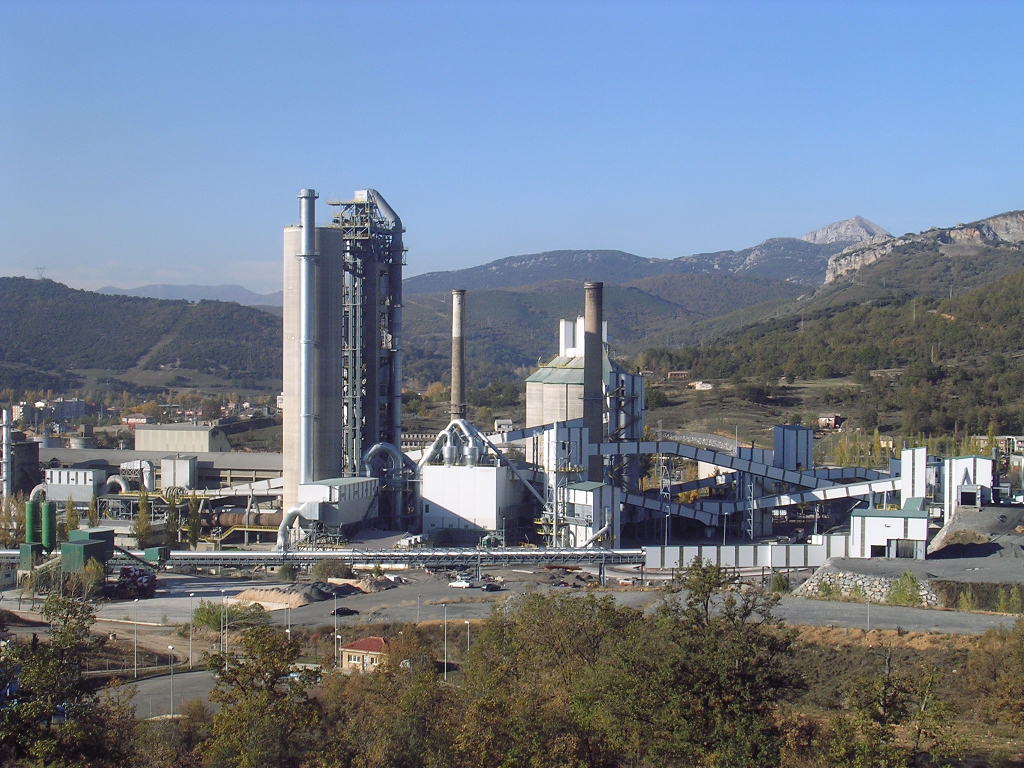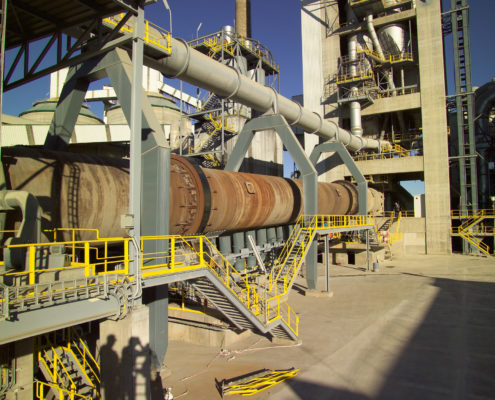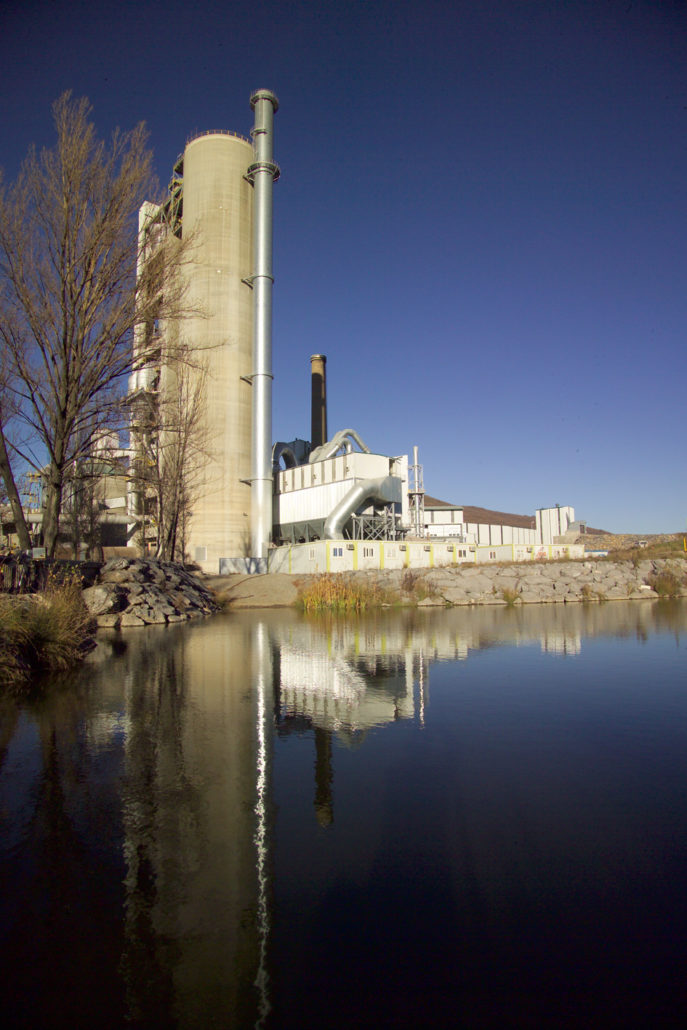The cement factory, located in La Robla, was built by Hullera Vasco Leonesa at the start of the sixties and was acquired, through the purchase of Sociedad Cementos La Robla S.A., by SOCIEDAD ANONIMA TUDELA VEGUIN, nowadays Cementos Tudela Veguín S.A., in the latter part of the sixties. The wet-process clinker manufacturing and the limitation on the production of its two kilns, made the factory survive in precarious conditions due to the energy costs that were hardly assumable..
The project for a new factory commenced in 2002, with a single dry process kiln with an annual clinker production capacity of 1,000,000 t which included the latest advances regarding environmental and energy issues and which, having been inaugurated in November 2004, is currently the most modern in Europe.

The process starts in the quarry with contrasted reserves for over 40 years, whose installations, with a 1,300 t/h production capacity, are located in the exploitation gap to minimise the environmental impact. The raw material is transported from the quarry to the factory on a 4,100 metre-long conveyor belt without transfers, with a fairing throughout its entire length, in its last section going under one side of the village of La Robla, river Bernesga, national road N630 and the railway track, along a tunnel 1,500 metres long taking the material to a pre-homogenization bay with a surface area of 30,000 m2, where the fossil fuel used in the process is also stored..
The raw material is controlled by means of a CNA 7continuous neutron analyser.
A cuadropol mill with a 2200 kW motor and a 260 t/h production capacity conditions the material supplying the kiln, homogenized in a silo 110 metres high and with a capacity for 16,000 tonnes.

45% of the fuel consumption is carried out in the main burner and 55% in the combustion chamber located at the level of the 2nd cyclone stage of the Dopol heat exchanger, a system that allows for minimising the production of NOx . This chamber is one of the point for introducing alternative fuels in the kiln, in sizes under 200 mm, given its oxidising atmosphere, alkaline environment and temperature conditions.
The Polysius kiln, 60m long, with two supports and 4.20m in diameter, is the nucleus of the clinker manufacturing process, with a production capacity exceeding 3,000 t/day. The fuels used are petroleum coke, as base fuel, and fuel oil or gas for ignition and heating. Also, given its exceptional qualities regarding environmental behaviour it is capable of valuating all kinds of alternative fuel in its main burner.
The clinker exiting the kiln is cooled on a Polytrac with 3 grills, one static and two mobile ones, between which there is a 4-roller crushers and 7 fans to cool the material which is taken, by means of a bucket conveyor, to 2 silos with a capacity for 50,000 tonnes each.
The cement production capacity is of 1,200,000 t/year. The factory has three Fives Lille cement mills, with a capacity of 35 t/h each, provided with a closed milling circuit and latest generation dynamic separators.
The cement is stored in eight silos from where the cement is distributed in bulk, by road or railway, or put in sacks, loaded onto pallets and covered with plastic in the corresponding installation with a capacity for 70 t/h .
 The factory has the MTDs for the cement sector and is totally automated with a POLCID system for analysis of the different process stages, all being centralised in a room from which the entire manufacturing process from the quarry to the bulk distribution of cement is controlled.
The factory has the MTDs for the cement sector and is totally automated with a POLCID system for analysis of the different process stages, all being centralised in a room from which the entire manufacturing process from the quarry to the bulk distribution of cement is controlled.
Ensuring the quality of the clinker, of the cement produced and of the manufacturing processes has always been a priority goal to achieve, for which reason there has been a quality control system in place for many years. It used to be an internal system, since 1988 it is the AENOR Certificate for Products with the N, and now it is according to the UNE-EN 197-1:2011 and UNE-EN 196-10:2008 standards, a strict Quality Management external control system having been implemented since 2001 to ensure the efficiency of the production process, the AENOR Registered Company certificate according to standard ISO 9001: 2015.
Likewise, aware of the fact the manufacture of our products involves an inevitable environmental impact and in order to minimise this, we have successfully implemented an Environmental System in accordance with standard UNE-EN ISO 14001:2015 since 2007, integrating the protection of the environment with the normal operating of the factory.
The factory of La Robla obtained the IEA (Integrated Environmental Authorisation) in 2008, among other things authorising the use of alternative fuels for the first time. Technical activity environmentally contrasted with the experience of over four decades in the most developed European countries regarding environmental protection. The installation for alternative fuel valuation in the combustion chamber came into service in August 2009. This was supplemented by the main burner in May 2011. Project subsidised by the Ministry of Industry to Encourage Competitiveness in 2011.

In this short period of time and thanks to its modern installations, it was possible to reach thermal substitution ratios of 42% in 2011, exceeding even the European average for 2009, 28.1%, the last year for which figures are available.
All this with the highest respect towards the environment. The many controls performed by the Entities Collaborating with the Administration make it clear that under no circumstance have we reached the authorised emission values appearing in the IEA, with the average of these values being 20% under the authorised limit values. This confirms the vast experience existing in the European clinker kilns that have been carrying out this activity for decades.



 Industria
Industria Bodegas
Bodegas Aparcamientos
Aparcamientos Inmobiliaria
Inmobiliaria Medicina
Medicina Internacional
Internacional Arte
Arte